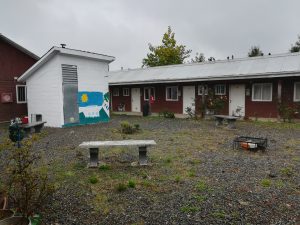Summary
 En Valdivia existe un Condominio de Vivienda Tutelada (CVT) llamado Nueva Esperanza destinado a entregar una solución habitacional a personas mayores vulnerables que no tienen una casa donde vivir.
En Valdivia existe un Condominio de Vivienda Tutelada (CVT) llamado Nueva Esperanza destinado a entregar una solución habitacional a personas mayores vulnerables que no tienen una casa donde vivir.
El CVT de Valdivia tiene 20 casas. La principal característica de las viviendas es que están especialmente equipadas para los adultos mayores, con el objetivo de promover la autovalencia. Cada casa cuenta con un dormitorio tipo suite con baño privado, cocina-comedor en una superficie de 22 metros cuadrados. Además, los beneficiarios cuentan con espacios de uso común, una sede comunitaria y áreas verdes.
Los CVT fortalecen la autonomía y la vida en comunidad. Ellos son operador por los municipios y organizaciones de la sociedad civil a través de un monitor que se encarga de potenciar a los adultos mayores, entregarles herramientas, motivar actividades en conjunto y ayudarlos a disfrutar la última etapa de la vida.
Elisa Riveros, de 86 años, es una de las residentas. Hace dos años llegó a habitar el condominio. Se vino de Santiago con la intención de vivir con sus hijos que residían en la ciudad, sin embargo, eso no se concretó: “Aquí lo pasamos bien, tenemos unión con todos los vecinos, nos protegemos, hacemos reuniones, almuerzos y onces”. Para ella, envejecer junto a otros adultos mayores es beneficioso. «Entre todos nos preguntamos ‘cómo amaneció vecino’, y si uno durmió mal le decimos ‘tómese una agüita de hierbas’, nos cuidamos y lo pasamos bien», expresó.
In Valdivia there is a Sheltered Housing Condominium (CVT) called Nueva Esperanza designed to bring a housing solution to vulnerable elderly people who don’t have a home to live in. CVT Valdivia has 20 departments.
The main characteristic of the houses is that they are specially equipped for the elderly, with the aim of promoting self-preservation. Each house has a bedroom suite with private bathroom, kitchen-dining room in an area of 22 square meters. In addition, the beneficiaries have spaces for common use, a community office and green areas.
CVTs strengthen autonomy and community life. They are operated by municipalities and civil society organizations through a monitor that is responsible for empowering older adults, provide tools, motivate activities together and help them enjoy the last stage of life.
Elisa Riveros, 86, is one of the residents. Two years ago she arrives to the condominium. She came from Santiago with the intention of living with her son who lived in the city, however, that did not materialize: “Here we have a good time, we have union with all the neighbors, we protect ourselves, we have meetings, lunches and cakes”. For her, aging along with other older adults is beneficial. “Among all we asked ‘how dawned neighbor’, and if one slept badly we say ‘take a little tea,’ we take care of ourselves and have a good time,” she said.
Key facts
Main target group: Vulnerable older people (e.g. at risk or victims of abuse, living alone, poor etc.)
Sector(s): Housing
Desired outcome for older people:
Meet their basic needs
- Ageism
- Healthy behaviours (e.g. physical activity)
- Intergenerational activities
- Inclusion
- Participation

